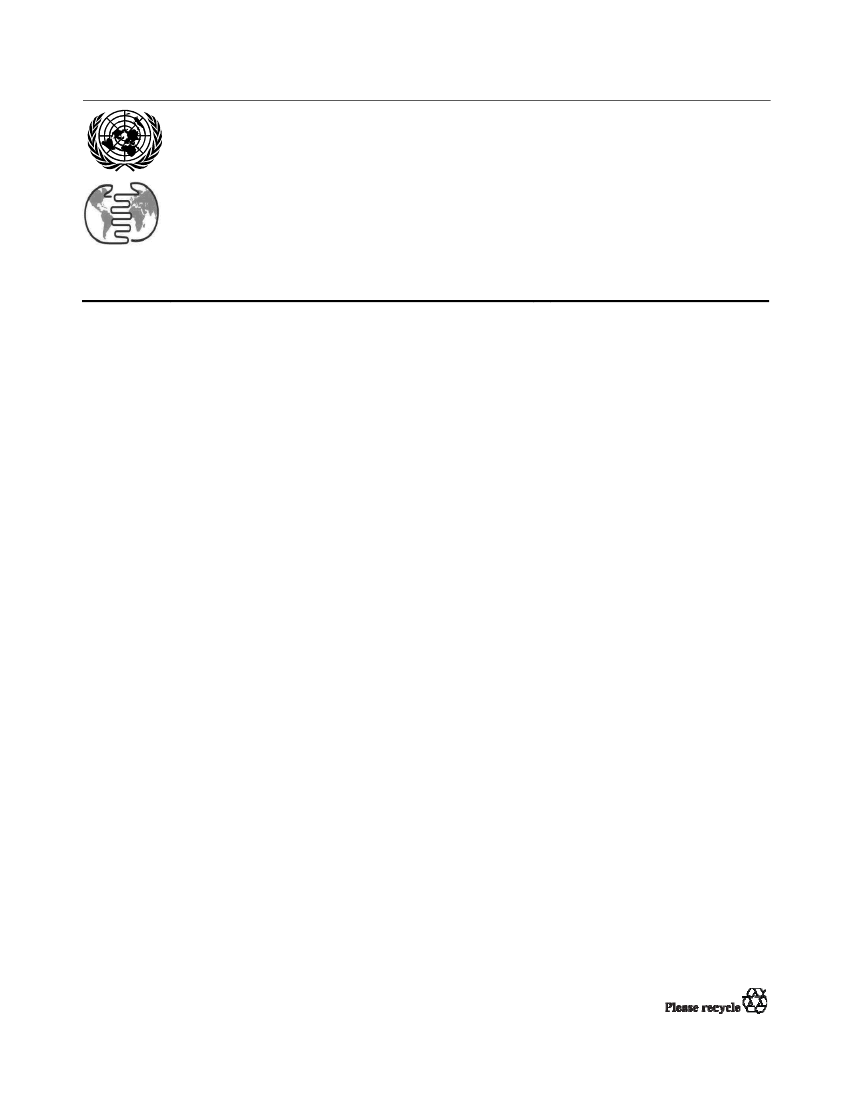Udenrigsudvalget 2010-11 (1. samling)
URU Alm.del Bilag 205
Offentligt
United Nations
A/CONF.219/3Distr.: General11 May 2011Original: English
Fourth United Nations Conferenceon the Least Developed CountriesIstanbul, Turkey9-13 May 2011
Fourth United Nations Conference on theLeast Developed CountriesIstanbul, 9-13 May 2011
Programme of Action for the Least Developed Countries forthe Decade 2011-2020I. Introduction1.The least developed countries, consisting of 48 countries with a totalpopulation of 880 million, represent the poorest and weakest segment of theinternational community. Least developed countries are characterized by constraintssuch as low per capita income, low level of human development, and economic andstructural handicaps to growth that limit resilience to vulnerabilities.2.In the decade since the adoption of the Brussels Programme of Action in 2001,least developed countries have made some progress in economic, social and humandevelopment. In this regard, we welcome the efforts made by least developedcountries themselves and their development partners. However, there is no room forcomplacency, as more than 75 per cent of the least developed countries’ populationstill live in poverty. It is a matter of deep concern to the international communitythat only three countries have graduated out of this category so far in the past threedecades.3.The least developed countries continue to have the lowest per capita incomesand the highest population growth rates. They are the most off track in theachievement of the internationally agreed development goals, including theMillennium Development Goals, and are at the bottom of the Human DevelopmentIndex rankings. Least developed countries have been unable to overcome theireconomic vulnerability and structurally transform their economies or buildresilience against internal and external shocks and crisis.4.Least developed countries’ productive capacity is limited, and they have severeinfrastructure deficits. Similarly, least developed countries continue to struggle withimproving human and social development. Some developed countries lack adequategovernance capacities and institutions, including those emerging from conflict.5.An evidence-based appraisal of the implementation of the Brussels Programmeof Action for the Least Developed Countries for the Decade 2001-2010 confirmsthat a more strategic, comprehensive, and sustained approach based on ambitious,11-32947 (E) 120511
*1132947*
A/CONF.219/3
focused and realistic commitments is required to bring about structuraltransformation in least developed countries that fosters accelerated, sustained,inclusive and equitable economic growth and sustainable development and helpsleast developed countries meet long-standing as well as emerging challenges.6.Since the Third United Nations Conference on the Least Developed Countries,the international economic and development landscape has been evolving, with anexpansion of the number of partners and actors and more complex aid, economicand financial architecture.7.In addition, new challenges have emerged. The international community hasbeen challenged by multiple and interrelated crises, including the ongoing impact ofthe financial and economic crisis, volatile energy and food prices and ongoingconcerns over food security, as well as the increasing challenges posed by climatechange and the loss of biodiversity, which all have increased vulnerabilities andinequalities and have adversely affected development gains in least developedcountries.8.Solidarity, cooperation and partnership with the least developed countries, thepoorest, most vulnerable and weakest countries and their people are not only moralimperatives, they are also economic and political ones. Least developed countriesrepresent an enormous human and natural resource potential for world economicgrowth, welfare, prosperity and food and energy security. A successful renewed andstrengthened global partnership that effectively addresses the special needs of leastdeveloped countries will contribute to the cause of peace, prosperity and sustainabledevelopment for all.9.In addition to the outcomes of previous United Nations Conferences on theLeast Developed Countries, the Millennium Declaration, the Monterrey Consensusof the International Conference on Financing for Development, the Plan ofImplementation of the World Summit on Sustainable Development (JohannesburgPlan of Implementation), the 2005 World Summit Outcome, the Doha Declarationon Financing for Development and the outcome document of the High-level PlenaryMeeting of the General Assembly on the Millennium Development Goals havereaffirmed that least developed countries deserve particular attention and well-targeted support measures to eradicate poverty, accelerate economic growth, achievesustainable development and overcome their vulnerabilities.10. The Programme of Action for the decade 2011 to 2020 represents the enhancedcommitments of the least developed countries, which have the ownership andprimary responsibility for their own development, and their development partners toa renewed and strengthened global partnership.10 alt 1 ter.This partnership also includes the United Nations system, includingthe Bretton Woods institutions, other multilateral institutions and regionaldevelopment banks, within their respective mandates.10 alt 1 bis.Guided by the spirit of solidarity with least developed countries,developing countries, consistent with their capabilities, will provide support for theeffective implementation of the Programme of Action in mutually agreed areas ofcooperation within the framework of South-South cooperation, which is acomplement but not a substitute for North-South cooperation.
2
11-32947
A/CONF.219/3
10 alt 1 quat.The private sector, civil society and foundations will be encouragedto contribute to the implementation of the Programme of Action in their respectiveareas of competence in line with least developed countries’ national priorities.
II. Review of the implementation of the Brussels Programmeof Action14. The Brussels Programme of Action was based on seven commitments aimed atsignificantly improving the human conditions of people in least developedcountries, through providing a framework for a strong global partnership. Itsoverarching goal was to make substantial progress towards halving the proportion ofpeople living in extreme poverty and suffering from hunger by 2015 and promotesustainable development in least developed countries. Significant and steady growthof gross domestic product (GDP) was seen as the main requirement for reaching theoverarching goal.15. Economic and social development was better during the implementation of theBrussels Programme of Action than during the previous decade, despite largedifferences among individual least developed countries. Some least developedcountries achieved growth rates exceeding 7 per cent annually, but in many leastdeveloped countries growth remained significantly lower and some least developedcountries experienced negative growth rates. During the decade, least developedcountries’ participation in international trade was increased, although their share inglobal trade remains marginal.16. The least developed countries made some progress towards reaching theMillennium Development Goals, particularly in the field of universal primaryeducation and gender equality in school enrolment, while many least developedcountries are off track in the rate of progress towards the target of reducing childmortality and improving maternal health. Large imbalances within and betweencountries persist in terms of the human and social goals of the Brussels Programmeof Action with respect to gender, rural-urban populations and other disadvantagedgroups.17. Least developed countries have also made some progress towards goodgovernance, especially with respect to efforts to embed and institutionalizedemocratic governance in their own processes and with respect to the empowermentof women.18. While the Brussels Programme of Action has had a positive role to play in thedevelopment process of the least developed countries, the specific goals and actionof the Brussels Programme of Action have not been fully achieved. The improvedeconomic performance in some least developed countries had a limited impact onemployment creation and poverty reduction. In many least developed countriesstructural transformation was very limited, and their vulnerability to external shockshas not been reduced.19. Changes in the sectoral composition of GDP have been much slower in manyleast developed countries than in other developing countries. In particular, the shareof manufacturing, which has been the driving force of economic development inmany middle-income countries, has increased only slowly.
11-32947
3
A/CONF.219/3
21. Many least developed countries are net food importers, which has increasedtheir vulnerability to rapid declines in export earnings and capital flows. Multiple,interrelated global crises and challenges, such as increased food insecurity, volatileenergy and commodity prices, and the global financial and economic crisis partlyreversed development gains that least developed countries achieved over the years.22. The implementation of development strategies in least developed countriesimproved and development partners increased their contributions during the periodof implementation of the Brussels Programme of Action. Progress has also beenmade in addressing the needs of least developed countries regarding financial andtechnical assistance, ODA, trade capacity, market access and debt relief, though notall commitments and targets have been fully realized.23. While the least developed countries have made considerable efforts tomobilize domestic resources for their development, most of them still face a hugefinancing gap, and ODA continued to be the largest source of external financing forthe development of least developed countries. The aggregate ratio of ODA to grossnational income (GNI) for Development Assistance Committee (DAC) membersincreased from 0.05 per cent in 1997-1998 to 0.09 per cent in 2008, but remainedwell below the 0.15-0.20 per cent target. An increasing share of aid went to thesocial sectors, rather than building physical and economic infrastructure.24. The share of least developed countries’ exports in international merchandisetrade increased from 0.62 per cent in 2002 to 1.08 per cent in 2008. Progress hasbeen made towards fulfilling commitments on duty-free quota-free market accessfor products originating in least developed countries in conformity with the HongKong Ministerial Declaration adopted by the World Trade Organization in 2005.However, full realization is yet to be achieved. Some countries have, or madeconsiderable efforts to implement simple and transparent rules of origin for leastdeveloped country products, but other serious obstacles to trade remain, includingnon-tariff barriers that are inconsistent with World Trade Organization rules andobligations and supply side constraints, in particular lack of infrastructure andmodern technologies and energy deficiency.25. The Heavily Indebted Poor Countries (HIPC) Initiative and the MultilateralDebt Relief Initiative (MDRI) have had a positive impact on development in manyleast developed countries, though not all least developed countries are eligible.However, owing to increased lending and borrowing during the financial crisis, debtdistress continues to be a major concern for least developed countries.26. Foreign direct investment to least developed countries has also increasedsubstantially, but without a visible impact on structural change. The investment-to-GDP ratio target of 25 per cent set in the Brussels Programme of Action was metonly partially by a few countries. Foreign direct investment flow remainedconcentrated on extractive industries with non-resource attracting sectors receivinga limited share of overall foreign direct investment flows to least developedcountries.27. There are some important lessons learned for the new Programme of Actionfrom the reviews of the Brussels Programme of Action at national, regional andglobal levels:(a) Some international support measures generated only limited results, asthey were insufficient in scope and scale to achieve the goals and objectives of the
4
11-32947
A/CONF.219/3
Brussels Programme of Action and the specific needs of the least developedcountries. In some cases there were implementation difficulties and a lack of policycoherence and consistency. International support measures should be strengthenedin terms of higher priority and specific targeting of least developed countries;(b) Treating least developed countries as a group on the basis of their lowper capita income, human asset development and economic, vulnerability remainsthe fundamental premise for special measures in their favour. This Programme ofAction needs to fully take into account the specific geographical constraints andvulnerabilities of each least developed country, including small island andlandlocked least developed countries, least developed countries with mountains andfragile ecology, low-lying coastal least developed countries, those with extremedependency on primary commodity exports, low agricultural productivity and foodinsecurity, climate and environmental vulnerability, energy insecurity and leastdeveloped countries emerging from conflict;(c) Greater ownership and leadership of least developed countries isindispensable, including the integration of the Programme of Action in nationaldevelopment strategies, plans and programmes, and identification of authorities tooversee implementation, as well as multi-stakeholder engagement byparliamentarians, civil society organizations, the private sector, and executivebranches;(move up as indent a)(d) The multiple crises created a new consciousness regarding instabilitiesand vulnerabilities of the global economy. It is important to refocus attention onstructural transformation of least developed countries through increasing productivecapacity and diversification and strengthening home-grown development paths;(e) Better integration of the Programme of Action into aid, trade anddevelopment strategies of development partners, is also crucial for its successfulimplementation and coherence of policies;(f) In addition to the development partners, the developing countries,consistent with their capabilities, can contribute to the implementation of the newProgramme of Action, within the context of South-South cooperation, as acomplement to, but not a substitute for, North-South cooperation;(g) The development strategy for the next decade should complement theexport-led growth strategies by focusing on the strengthened role of domesticproductive capacity, diversification, enhanced investments, infrastructuraldevelopment, building technological capacity, building and strengthening thecapacity of least developed country private sector that can stimulate enhanced andsustained, inclusive and equitable economic growth and structural transformation.There should be increased attention to agriculture and rural development and to foodand nutrition security. Regional integration, including in infrastructure, should alsobe given greater prominence;(h) Priority areas for support should be targeted, better matching these areaswith goals and targets, and specific means and tools to reach them should beidentified;h bis.Focus on issues like good governance at national and internationallevels and the fight against corruption, respect for human rights, gender issues,
11-32947
5
A/CONF.219/3
building institutional capacity, social protection and social services andenvironmental concerns is important to a broad approach to poverty eradication;(i) Enhanced financial resources are important to bring about structuraltransformation and to achieve sustainable development and poverty eradication inleast developed countries, as well as other goals of this Programme of Action. Thequantity, quality and predictability of resources should be addressed, as well as thebest ways to use dedicated regional and global facilities and mechanisms to providesupport to the least developed countries;(k) More effective representation of least developed countries in decision-making at the global level could improve the international environment for thedevelopment of the least developed countries. Wider recognition of least developedcountry status could stimulate and facilitate better integration of the Programme ofAction into development policies;(l) Monitoring and follow-up should not focus only on goals and targets, butalso on actions, to strengthen the principle of mutual accountability.
III. Renewed and strengthened partnership for developmentObjectives
11. The overarching goal of the Programme of Action for the decade 2011-2020 isto overcome the structural challenges faced by the least developed countries in orderto eradicate poverty, achieve internationally agreed development goals and enablegraduation from the least developed country category.12. Guided by the overarching goal, national policies of least developed countriesand international support measures during the decade will focus on the followingspecific objectives with the aim of enabling half the number of least developedcountries to meet the criteria for graduation by 2020:(a) Achieve sustained, equitable and inclusive economic growth in leastdeveloped countries, to at least at the level of 7 per cent per annum, bystrengthening their productive capacity in all sectors through structuraltransformation and overcoming their marginalization through their effectiveintegration into the global economy, including through regional integration;(b) Build human capacities by fostering sustained, equitable and inclusivehuman and social development, gender equality and the empowerment of women;(c) Reduce the vulnerability of least developed countries to economic,natural and environmental shocks and disasters, as well as climate change, andenhance their ability to meet these and other challenges through strengthening theirresilience;(d) Ensure enhanced financial resources and their effective use for leastdeveloped countries’ development, including through domestic resourcemobilization, official development assistance (ODA), external debt relief, foreigndirect investment and remittances;(e) Enhance good governance at all levels, by strengthening democraticprocesses, institutions and the rule of law; increasing efficiency, coherence,transparency and participation; protecting and promoting human rights; and11-32947
6
A/CONF.219/3
reducing corruption, and strengthen least developed country Governments’ capacityto play an effective role in their economic and social development.Principles
13. The following principles will guide the implementation of the Programme ofAction based on a strengthened framework of partnership for successfully achievingits objectives:(a)Country ownership and leadership.The ownership, leadership andprimary responsibility for their own development lies with least developedcountries. Least developed countries have the right and responsibility to formulateand execute their own coherent economic and development policies and strategiesand identify their own national priorities, including striking a balance in theallocation of resources between economic and social sectors. Development partnersshould support least developed countries in the design and implementation of theirdevelopment strategies;(b)An integrated approachin which the development process in leastdeveloped countries should be viewed in a comprehensive and holistic manner. Thepromotion of policy coherence and consistency of the international economic,financial and trading systems with the aim of increasing the quantity, quality andeffectiveness of least developed country-focused international support measures andmechanisms is of key importance. The implementation of the Programme of Actionshould be integrated into all relevant international processes;(c)Genuine partnershipand solidarity with understanding and recognitionthat the least developed countries, as the most vulnerable group of countries, needeffective national policies, enhanced global support and appropriate mechanisms atall levels for the achievement of the goals and objectives of this Programme ofAction;(d)Result orientation.The success of the Programme of Action will bejudged by its contribution to internationally agreed development goals and targetsand enabling the least developed countries to graduate. The process ofidentification, monitoring and assessment of progress in implementing actions andrealizing the goals and objectives of the Programme of Action will contribute toenhancing mutual accountability and effectiveness of development cooperation;(e)Peace and security, development and human rights,as pillars of theUnited Nations system and the foundation for collective security and well-being, areinterdependent, interlinked and mutually reinforcing. Development requires andstrengthens freedom, peace and security, good governance, respect for all humanrights, including the right to food, the rule of law, gender equality, respect for natureand an overall commitment to just and democratic societies. The particularchallenges faced by some least developed countries regarding conflict and theirhuman, economic and social implications need to be recognized and their stabilityenhanced. In an interdependent and interconnected world, each member of theinternational community has stakes in common security, prosperity and welfare.Eradication of poverty and hunger in least developed countries, among others,would contribute towards ensuring global stability and prosperity in a sustainablemanner;
11-32947
7
A/CONF.219/3
(f)Equityat all levels is indispensable for the pursuit of long-termprosperity and the realization of all the internationally recognized human rights,including the right to development by all. Development strategies and programmesof least developed countries and their partners should strive to enhance theparticipation and empowerment of the poor and marginalized in their owndevelopment, benefit the most vulnerable, ensuring social justice, democracy,gender equality, and sustained, inclusive and equitable economic growth andsustainable development;(g)Voice and representation.The international economic system andarchitecture should be inclusive and responsive to the special development needs ofleast developed countries, ensuring their effective participation, voice andrepresentation at all levels;(h)Balanced role of the State and market considerations,where theGovernment in least developed countries commits to design policies and institutionswith a view to achieving sustainable and inclusive economic growth that translatesinto full employment, decent work opportunities and sustainable development. TheState also plays a significant role in stimulating the private sector towards theachievement of national development objectives and creates an appropriate enablingstable, transparent and rules-based economic environment for the effectivefunctioning of markets.Renewed and strengthened partnership for development
28. The Istanbul Programme of Action is based on commitments, accountabilityand partnership between least developed countries and their development partners toundertake concrete actions in a number of interlinked areas. This requires supportiveand integrated policies across a wide range of economic, social and environmentalissues consistent with the objectives of this Programme of Action.30. Each least developed country will translate policies and measures in theProgramme of Action into concrete measures by integrating this Programme ofAction into the national and sectoral development strategies and plans. It isrecognized that the increasing interdependence of national economies in aglobalizing world and the emergence of rules-based regimes for internationaleconomic relations have meant that the space for national economic policy, that is,the scope for domestic policies, especially in the areas of trade, investment andinternational development, is now often framed by international disciplines,commitments and global market considerations. It is for each Government toevaluate the trade-off between the benefits of accepting international rules andcommitments and the constraints posed by the loss of policy space.31. National efforts of least developed countries should be complemented bysupportive global programmes, measures and policies aimed at expanding thedevelopment opportunities of least developed countries and responding to theirevolving national priorities.32. Development partners will implement on their part this Programme of Actionby integrating it into their respective national cooperation policy frameworks,programmes and activities, as appropriate, to ensure enhanced, predictable andtargeted support to least developed countries, as set out in the Programme of Action.
8
11-32947
A/CONF.219/3
33. Developing countries, consistent with their capabilities, in the context ofSouth-South cooperation, will support the effective implementation of thisProgramme of Action, in accordance with the provisions in section IV bis.33 bis.Subregional and regional cooperation can play a critical role inpromoting sustained, inclusive and equitable economic growth and sustainabledevelopment in least developed countries, including through enhanced subregionaland regional connectivity, both physical and institutional, and strengthenedresponses to threats and crises of various kinds. The importance of advancing andsupporting subregional and regional cooperation efforts in favour of least developedcountries should be stressed.35. As long-term partners in the development process of least developed countries,the organizations of the United Nations system, including the Bretton Woodinstitutions, have a special role to play in the implementation of the Programme ofAction.36. Parliaments have an important role in debating development strategies as wellas overseeing their implementation. The engagement of parliaments will ensureeffectiveness, transparency and accountability in the design, implementation andreview of the policies and programmes in the context of the Programme of Action.37. Partnerships with the private sector play an important role for promotingentrepreneurship, generating employment and investment, increasing the revenuepotential, developing new technologies and enabling high, sustained, inclusive andequitable economic growth in least developed countries. Good governance at alllevels and an enabling business environment will play a key role in this respect.38. The Programme of Action recognizes that civil society complementsgovernment and the private sector in its implementation. Civil society organizationswill be involved in policy dialogue, as appropriate, to ensure a participatory andinclusive development process in least developed countries.39. The international trade and finance architecture should be supportive of andresponsive to the special needs and priorities of least developed countries, togetherwith enhanced coordination and coherence among the different policy areas of theinternational development architecture, including ODA, trade, foreign directinvestment, debt and finance, taking also into account new and emerging challenges.40. Development initiatives, including at the subregional, regional andinternational levels, such as the Group of 20 (G-20) Seoul Development Consensusfor Shared Growth and its Multi-Year Action Plan, are expected to contribute to theattainment of inclusive, sustainable and resilient growth in least developedcountries.41. Least developed countries and their development partners reaffirm theircommitment to a comprehensive, result-oriented, enhanced, quantifiable, forward-looking and coherent renewed and strengthened global partnership for leastdeveloped countries.
11-32947
9
A/CONF.219/3
IV. Priority areas for action42.The actions will be organized by priority areas as:• Productive capacity▪Infrastructure▪Energy▪Science, technology and innovation▪Private sector development• Agriculture, food security and rural development• Trade• Commodities• Human and social development▪Education and training▪Population and primary health▪Youth development▪Shelter▪Water and sanitation▪Gender equality and empowerment of women▪Social protection• Multiple crises and other emerging challenges▪Economic shocks▪Climate change and environmental sustainability▪Disaster risk reduction• Mobilizing financial resources for development and capacity-building▪Domestic resource mobilization▪Official development assistance▪External debt▪Foreign direct investment▪Remittances• Good governance at all levels
A.
Productive capacity43. Least developed countries’ economies feature limited productive capacities,which constrain their ability to produce efficiently and effectively, and to diversifytheir economies. This handicap translates into binding supply constraints and
10
11-32947
A/CONF.219/3
ultimately into weak export and economic potentials and limited productiveemployment generation and social development prospects. Building a critical massof viable and competitive productive capacity in agriculture, manufacturing andservices are essential if least developed countries are to benefit from greaterintegration into the global economy, increase resilience to shocks, sustain inclusiveand equitable growth as well as poverty eradication, achieve structuraltransformation, and generate full and productive employment and decent work forall.45. The followinggoals and targetsmay be pursued, in accordance with nationaldevelopment policies and strategies:(a) Increase significantly the value addition in natural resource-basedindustries paying special attention to employment generation;(b) Diversify local productive and export capability with a focus on dynamicvalue added sectors in agriculture, manufacturing and services;(c) Significantly increase access to telecommunication services and strive toprovide 100 per cent access to the Internet by 2020;(d) Strive to increase total primary energy supply per capita to the same levelas other developing countries;(e) Significantly increase the share of electricity generation throughrenewable energy sources by 2020;e.bis.Enhance capacities in energy production, trade and distribution with theaim of ensuring access to energy for all by 2030;(f) Ensure that the least developed countries have significant increase incombined rail and paved road mileage, and sea and air networks by 2020.46. Actions by the least developed countries and their development partners onproductive capacities will be along the following lines:1.Joint actions(c) Establish or upgrade quality assurance and standards of products andservices to meet international standards.(move under actions by least developedcountries as (c))2.Action by least developed countries(a) Ensure that productive-capacity development agenda is mainstreamedinto national development policies and strategies;(b) Increase the share of least developed country government spending inproductive capacity-building;(c) Strengthen the capacity of domestic financial institutions to reach out tothose who have no access to banking, insurance and other financial services,including through leveraging the contribution of, among others, micro-finance,micro-insurance, and mutual funds, in creating and expanding financial servicestargeted to poor and low-income populations, as well as small- and medium-sizeenterprises;
11-32947
11
A/CONF.219/3
(d) Foster economic activity by promoting, inter alia, economic clusters,removing obstacles to business and prioritizing domestic and foreign investments,which increases connectedness;(e) Support the least developed countries’ efforts to develop a sustainabletourism sector, in particular through infrastructure and human capital development,increased access to finance and enhanced access to global tourism networks anddistribution channels;(move under action by development partners)(f) Strengthen programmes for promoting agro-processing industries withvalue addition as a means to increase agricultural productivity, raise rural incomesand foster stronger linkages between agriculture and industries.3.Action by development partnersa0. Provide enhanced financial and technical support to least developedcountries to develop productive capacities in line with least developed countries’priorities;a01.Support least developed countries in diversification and value addition bytheir firms to effectively participate in the global value chains;(a) Adopt, expand and implement investment promotion regimes, asappropriate, in the form of risk and guarantee schemes and other incentives infavour of their firms seeking to invest in productive capacity development in leastdeveloped countries;(c) Support the development of science and technology to increaseagricultural production and productivity.Infrastructure
47. One of the major challenges facing least developed countries is the lack ofadequate physical infrastructure, including electricity, transport, ICT and water andinstitutional capacity. Reliable and affordable infrastructure services are essentialfor efficient operation of existing productive assets and enterprises in leastdeveloped countries, attracting new investment, connecting producers to market,assuring meaningful economic development and promoting regional integration.When designed in a regional perspective, infrastructure development couldcontribute to regional integration and region-wide production.49. Actions by the least developed countries and their development partners oninfrastructure will be along the following lines:1.Joint actions(a) Develop and implement comprehensive national infrastructuredevelopment and maintenance policies and plans encompassing all modes oftransport, communications, energy and ports.(move under action by leastdeveloped countries as (b))2.Action by least developed countries(a) Allocate and disburse annually an adequate percentage of the budget forthe development and maintenance of infrastructure;
12
11-32947
A/CONF.219/3
(b) Develop and implement comprehensive national policies and plans forinfrastructure development and maintenance encompassing all modes oftransportation and ports, communications and energy;(c) Develop modern ICT infrastructure and Internet access, includingexpansion into rural and remote areas, including through mobile broadband andsatellite connections;(d) Build and expand broadband connectivity, e-networking and e-connectivityin relevant areas, including education, banking, health and governance;d.bis.Promote public-private partnerships for the developmentmaintenance of transport and ICT infrastructure and their sustainability;and
(f) Promote bilateral, subregional and regional approaches to improveconnectivity by removing infrastructure bottlenecks.3.Action by development partners(a) Provide enhanced financial and technical support for infrastructuredevelopment in line with least developed countries’ sectoral and development needsand priorities and use concessional funds, where appropriate, to catalyse andleverage other sources of funding for infrastructure development and management;a.ter.Support least developed countries’ efforts to facilitate the transfer ofrelevant skills, knowledge and technology for the development of infrastructure onmutually agreed terms;alt.d.Actively support private sector investment, including through public-private partnerships and grant/loans blending, for infrastructure development andmaintenance in communication and multimodal transport such as railways, roads,waterways, warehouses and port facilities;(b) Provide assistance to landlocked and small-island least developedcountries aimed at addressing the challenges of their remoteness from internationalmarkets and lack of infrastructure connectivity.Energy
50. The levels of production and access to energy in the majority of leastdeveloped countries are inadequate, seriously constraining the development of leastdeveloped countries. Access to affordable, reliable and renewable energy and relatedtechnologies on mutually agreed terms and conditions and the efficient use anddistribution of energy will be critically important in enhancing productive capacity,which is a key to achieving sustained economic growth and sustainabledevelopment.51. Actions by the least developed countries and their development partners onenergy will be along the following lines:1.2.Joint actionsAction by least developed countriesa.o.Ensure that energy sector receives priority in budget allocation;
11-32947
13
A/CONF.219/3
(a) Adopt integrated energy security development policies, strategies andplans to build a strong energy sector that ensures access to affordable, sustainableand reliable energy for all and promotes sustained, inclusive and equitable economicgrowth and sustainable development;a.bis.Improve efficiency in the generation, transmission and distribution ofenergy and sustainable use of energy resources;(b) Expand power infrastructure and increase capacity for energy generation,especially renewable energy which includes, inter alia, hydro power, geothermal,tidal, solar, wind and biomass energy.3.Action by development partnersa.o.Provide enhanced financial and technical support to the least developedcountries to improve efficiency in the generation, transmission and distribution andthe sustainable use of energy resources with the aim of ensuring access to energy forall;(a) Support least developed countries’ efforts to develop the energy sector ingeneration, distribution and energy efficiency, including in renewable energy, otherclean energy sources and natural gas, inter alia, through financial and technicalassistance and by facilitating private sector investment, in accordance with nationalpriorities and needs;(b) Facilitate the transfer of appropriate and affordable technology onmutually agreed terms and conditions for the development of clean and renewableenergy technologies in accordance with relevant international agreements.Science, technology and innovation
52. Science, technology and innovation play an important role in development. Allleast developed countries are lagging behind in these critical areas which are keydrivers for transformation and have great potentials to change the developmentlandscape of least developed countries if developed and harnessed properly. Leastdeveloped countries have often not been able to move beyond outdated technologiesthat characterize their production processes and outputs. Acquiring newtechnologies and building domestic capacity and knowledge base to be able to fullyutilize acquired technologies and promoting indigenous capacity on a sustainablebasis for research and development are needed to enhance productive capacities inleast developed countries. Furthermore, development of this sector should help tobridge the digital divide and technology gap in support of rapid poverty eradicationand sustainable development.53. Actions by the least developed countries and their development partners onscience, technology and innovation will be along the following lines:1.Joint actions(b) Undertake on a priority basis by 2013 a joint gap and capacity analysiswith the aim of establishing a Technology Bank and Science, Technology andInformation supporting mechanism, dedicated to least developed countries whichwould help improve least developed countries’ scientific research and innovationbase, promote networking among researchers and research institutions, help least
14
11-32947
A/CONF.219/3
developed countries access and utilize critical technologies, and draw togetherbilateral initiatives, support by multilateral institutions and the private sector,building on the existing international initiatives.2.Action by least developed countriesao.Build or expand strategic partnerships with a broad range of actors,including the private sector, universities and other research institutions andfoundations, in order to support innovation;(a) Ensure that science and technology are mainstreamed into leastdeveloped country national development and sectoral policies;a bis.Ensure that the development of science, technology and innovationreceives priority in budget allocation;(b) Promote investments and engagement in innovative solutions for thedevelopment of modern and cost-effective technologies that could be locallyadapted, particularly in the fields of agriculture, information and communication,finance, energy, health, water and sanitation and education;(c) Set up and strengthen, as applicable, institutions and expand theknowledge base to support local, national and regional research and development,science and technology;(d) Facilitate cooperation and collaboration between research institutions andthe private sector, with a view to promoting research and development andinnovation in the field of science and technology.3.Action by the development partners(a) Provide enhanced financial and technical support to least developedcountry research and development, science and technology, including strengtheningnational and regional institutions, as appropriate and in line with least developedcountries’ national development priorities;(b) Urge World Trade Organization members to continue to implementarticle 7 of the 2001 Doha Ministerial Declaration on the Agreement on Trade-Related Aspects of Intellectual Property Rights (TRIPS) and Public Health;(d) Consider the provision of concessional start-up financing for leastdeveloped country firms which invest in new technologies.Private sector development
54. A dynamic, broadly based, well functioning and socially responsible privatesector is a valuable instrument for increasing investment and trade, employment andinnovation, thereby generating economic growth and eradicating poverty andserving as an engine for industrialization and structural transformation. The privatesector therefore is a key to sustained, inclusive and equitable economic growth andsustainable development in least developed countries.55. Least developed countries have recognized the role of the private sector intheir development process and have taken a number of measures to improvecorporate governance and create an enabling environment for conducting business.Given the nature of least developed countries’ economies, the development of small
11-32947
15
A/CONF.219/3
and medium-sized enterprises holds a promising opportunity for the emergence of avibrant business community in least developed countries. However, structuralconstraints, particularly infrastructural bottlenecks, and institutional constraintshave limited the growth of the private sector in least developed countries.56. Actions by the least developed countries and their development partners inprivate sector development will be along the following lines:1.2.Joint actionsAction by least developed countriesContinue promoting an enabling environment for private sector developmentincluding for small and medium-sized enterprises through a transparent and rule-based regulatory framework.bis.Promote a dialogue between the private sector and government andstrengthen public-private partnerships with a view to ensuring that policies addresskey constraints, including institutional constraints, to the private sector’scontribution to sustainable and inclusive growth, promote corporate socialresponsibility and make use of potential synergies.ter.Make efforts to promote the availability of financial services, includingbanking and insurance, to enhance private sector development and investmentsacross sectors.quat.Promote women entrepreneurship to make better use of untappedeconomic potential in least developed countries.3.Action by development partners(a) Provide enhanced financial and technical support, and facilitate transferof technology, on mutually agreed terms to least developed countries to removestructural and institutional constraints on the private sector;(b) Support initiatives to strengthen the institutional and managerialcapacities and the productivity of small and medium-sized enterprises in leastdeveloped countries to improve their competitiveness.
B.
Agriculture, food and nutritional security and rural development57. Agriculture plays a crucial role in almost all least developed countries, both inpromoting food security and as the major economic activity for much of thepopulation, with direct linkages to the eradication of poverty and hunger, ruraldevelopment and gender equality and empowerment of women, as well as exports,commodity and production diversification and agro-processing capacity. It is onlythrough access to safe and nutritious food that those living in poverty and are mostat risk of chronic malnutrition, and, in particular, women, children and the elderlycan improve their health and nutrition status.58. The agriculture sector in least developed countries faces huge challengesowing to lack of adequate investment in physical infrastructure, scientific andtechnological development, research and agricultural extension services.Furthermore, agriculture development has been suffering from adverse impacts of
16
11-32947
A/CONF.219/3
climate change, environmental degradation, desertification, land and soildegradation, extreme weather events, floods, droughts and cyclones, deforestationand loss of biodiversity, declining water availability and degrading water quality.Other natural disasters such as earthquakes and tsunamis can also have negativeimpacts on sustainable agricultural development.58 bis.New investments are required in regional and national agricultural andfishery research and rural infrastructure, extension of better farming and fishingpractices and innovative and sustainable technologies, as well as marketing advice,structured and effective finance and greater tenure security, including access to andcontrol over land by female farmers irrespective of their marital status.59.Policies and measures will be pursued in line with the followingtargets:(a)(b)Make substantial progress towards eradicating hunger by 2020;Substantially increase investment in rural infrastructure;
(c) Ensure access to safe food and emergency food assistance in all leastdeveloped countries.60. Actions by the least developed countries and their development partners inagriculture will be along the following lines:1.Joint actionsa.o.Strive for a comprehensive twin-track approach to food security thatconsists of (i) direct action to immediately tackle hunger in least developedcountries; (ii) medium- and long-term sustainable agriculture, food security,nutrition and rural development policies and programmes to eliminate the rootcauses of hunger and poverty;(move under action by least developed countries)(c) Support national, regional and international agricultural and fisheryresearch institutions, as appropriate, build capacities in tropical agriculturaltechnologies and strengthen agricultural knowledge and information systemssupported by agricultural extension services targeting sustained, inclusive andequitable economic growth and poverty eradication in least developed countries;(move under action by least developed countries)(d) Support least developed countries to establish and upgrade their ownnational testing and certification institutions, as appropriate, to be recognized byglobal Sanitary and Phytosanitary Agreement institutions and support theparticipation of least developed countries in regional and global standard-setting;(move under action by the development partners)(e) Promote strategic and regulatory frameworks for foreign directinvestment and other resource flows in this sector that include vital policy areassuch as infrastructure development, trade and trade facilitation, research anddevelopment and transfer of technology;(move under foreign direct investmentsection)e bis.Promote responsible international investment in agriculture and call forall investors to conduct agricultural practices in accordance with nationallegislation, taking into account national sovereignty over natural resources,environmental sustainability and the importance of promoting the well-being and
11-32947
17
A/CONF.219/3
improving the livelihood of the local communities and indigenous people, asappropriate;(f) Further explore the feasibility, effectiveness and administrativemodalities of a system of stockholding in dealing with humanitarian foodemergencies or as a means to limit price volatility;f alt.bis.Pursue policy options to reduce price volatility, including improvedinformation system for stocks and production, greater transparency in commoditymarkets, free movement of food supplies;(h) Mainstream programmes to address desertification, land degradation, soilinfertility, droughts, floods and salination into national development policyframeworks to encourage resilience.(move under action by least developedcountries as (i)).2.Action by least developed countriesa.oStrengthen institutions, including cooperatives, to boost small-holderfarmer food production, agricultural productivity and sustainable agriculturalpractices;a.1.Provide safety nets to poor small-holder farmers;a.2.Supply critical inputs such as locally adapted High-yielding Varieties ofseeds, fertilizers and other services;a.3.Rehabilitate both rural and agricultural infrastructure, reducing post-harvest crop losses and improving village-level storage;a.4.Make rural markets work better for the poor by linking small-scalefarmers to markets throughout the food chains, including the provisions of price andother relevant information and improving sanitary and phytosanitary services;a.5.Implement irrigation schemes with a view to strengthening sustainableagriculture systems, increasing agricultural production and improving food security;a.5 bis.Enhance land tenure security, access to irrigation systems, credit, otherfarm inputs and markets for small-holder farmers;(a) Formulate and implement, in a participatory manner, effective nationalplans and policies relating to national food and nutritional security and agriculturaland rural development, with clear and achievable targets, including an allocation ofat least 10 per cent of government expenditures to agriculture;(b) Support the establishment and strengthening of transparent, efficient andeffective agricultural marketing and export systems, with particular emphasis onmarket access for small-holder farmers in least developed countries;(c) Encourage small farmers and pastoralists to change gradually from theproduction of low-value to high-value products, taking into account specialization,favourable market and infrastructural development conditions and improved accessto financial and risk management;(e) Promote the empowerment of rural women as critical agents forenhancing agricultural and rural development and food and nutritional security and
18
11-32947
A/CONF.219/3
ensuring their equal access to productive resources, land, financing, technologies,training and markets;e.bis.Mainstream food and nutritional security in marine and coastal resourcesmanagement plans and strategies.3.Action by development partnersao.Provide enhanced financial and technical support for the development ofthe agricultural sector;(a) Deliver on commitments made to achieve global food security andsustainable agricultural development, and provide adequate and predictableresources through bilateral and multilateral channels, including the commitments setout in the L’Aquila initiative on global food security;a.bis.Support efforts aimed at increasing agricultural production andproductivity;(b) Support least developed countries’ efforts to establish or strengthensafety nets such as access to agricultural finance, insurance and other risk-mitigationtools;(c) Provide resources to the relevant United Nations agencies to expand andenhance food assistance and safety net programmes to address hunger andmalnutrition, based on needs;(d) Fulfil in the Doha Development Agenda, the 2005 pledge of members ofthe World Trade Organization to ensure the parallel elimination in agriculture of allforms of export subsidies and disciplines on all export measures with equivalenteffect to be completed by the end of 2013;(move under joint actions)d.bis.Support least developed countries’ efforts to establish or strengthenagricultural and/or marine research and development institutions, as appropriate, inline with their national priorities, including through collaborative measures, with aview to building long-term institutional capacity;d.ter.Provide and support, as appropriate, least developed countries with high-yielding and climate-resilient crop varieties, including saline-, drought- andsubmersion-compatible species, through transfer of appropriate technology andtechnical know-how, on mutually agreed terms and conditions.
C.
Trade61. Trade has an important role in ensuring least developed countries’ sustainableeconomic development. Least developed countries’ collective share in internationaltrade has nearly doubled over the past 10 years, but it remains very low, at just over1 per cent of world merchandise trade, and is highly concentrated on a few exportproducts. Half of least developed countries’ exports flow to developing countries.61 bis.Least developed countries, with support from their development partners,should address supply-side constraints by enhancing productive capacities andreducing constraints on the private sector, as well as building and diversifying theirexport base.
11-32947
19
A/CONF.219/3
61 terIt is essential to seriously work towards creating favourable market accessconditions for all products originating in least developed countries, includingthrough the reduction or elimination of arbitrary or unjustified non-tariff barriersand other trade-distorting measures.62. Regional cooperation, including through regional trade integration and otherarrangements, can facilitate least developed countries’ development and theirbeneficial integration into the world economy by, inter alia, increasing the size ofmarkets, improving their competitiveness and enhancing regional connectivity.63. Policies and measures will be pursued in line with the followinggoals andtargets:alt a and b.Significantly increase the share of least developed countries’ tradein global trade with the aim of doubling the share of least developed countries’exports in global exports by 2020, including by broadening least developedcountries’ export base;(c) Realize timely implementation of duty-free quota-free market access, ona lasting basis, for all least developed countries consistent with the Hong KongMinisterial Declaration adopted by the World Trade Organization in 2005.(moveunder joint actions in para. 64)c bis.Make substantial efforts for an early and successful conclusion of theDoha Round of Trade Negotiations with an ambitious, comprehensive, balanced anddevelopment-oriented outcome.64. Actions by the least developed countries and their development partners ontrade will be along the following lines:1.Joint actions(b) Support least developed countries’ efforts in promoting subregional andregional cooperation, including export promotion and improving regionalconnectivity through trade-facilitating measures, such as joint projects on customsand border procedures, and insofar as possible transport infrastructure and linkages,telecommunications facilities and energy;(move under action by developmentpartners)b alt.Resist protectionist tendencies and rectify trade-distorting measures,including in agriculture, that are inconsistent with multilateral obligations;b bis.Address non-tariff measures and reduce or eliminate arbitrary orunjustified non-tariff barriers, i.e., those that are not in conformity with World TradeOrganization rules; standards and technical regulations must be developedtransparently and applied in a non-discriminatory manner, and should be technicallyjustified and not constitute a disguised restriction on international trade.2.Action by least developed countries(a) Integrate trade and trade capacity-building policies into nationaldevelopment strategies;(b) Improve productivity and competitiveness and diversify production basesinto dynamic new products and services;
20
11-32947
A/CONF.219/3
(c)
Diversify export products and markets to non-traditional destinations;
(d) Improve efficiency, efficacy and transparency of institutions andprocesses to better facilitate trade and improve standards and quality control.3.Action by development partners(c) Support least developed countries’ efforts to strengthen their human,institutional and regulatory capacities in trade policy and trade negotiations in areassuch as market entry and access, tariffs, customs, competition, investment andtechnology, and regional integration;(d) Provide technical and financial support to national and regional projectsthat are aimed at increasing the productivity, competitiveness and diversification ofleast developed country economies, including through strengthening the capacity oftheir trade in goods and services and of least developed countries’ firms to integrateinto international value chains;(e) Provide financial and technical support aimed at the diversification ofleast developed country economies, while providing financial and technicalassistance through appropriate delivery mechanisms to meet their implementationobligations, including fulfilling Sanitary and Phytosanitary Agreement andAgreement on Technical Barriers to Trade requirements, and to assist them inmanaging their adjustment processes, including those necessary to face the results ofmost favoured nation multilateral trade liberalization;(g) Reaffirm the provision of special and differential treatment for leastdeveloped countries in the World Trade Organization agreements;(move underjoint actions)(i) Ensure that preferential rules of origin applicable to imports from leastdeveloped countries are simple, transparent and predictable and contribute tofacilitating market access;(l) Facilitate and accelerate negotiations with acceding least developedcountries based on the accession guidelines adopted by the World TradeOrganization General Council in December 2002;(move under joint actions)m, n, o alt 1.Implement effective trade-related technical assistance andcapacity-building to least developed countries on a priority basis, including byenhancing the share of assistance to least developed countries for Aid for Trade andsupport for the Enhanced Integrated Framework, as appropriate, and strengtheningtheir capacity to access available resources, in support of the needs and demands ofleast developed countries expressed through their national development strategies;(q) Provide, in accordance with article 66.2 of the TRIPS Agreement,incentives to enterprises and institutions in developed country member territories forthe purpose of promoting and encouraging technology transfer to least developedcountries in order to enable them to create a sound and viable technological base.
D.
Commodities65. Many least developed countries remain commodity-dependent, with asignificant number relying primarily on agriculture or on the extraction of very few
11-32947
21
A/CONF.219/3
natural resources and primary products for export. This makes least developedcountries vulnerable to external trade shocks owing to volatility of commodityprices, which also impacts domestic resource mobilization. There is a need forconcerted measures and actions to support least developed countries’ efforts toreduce commodity dependence, including through the diversification of their exportbase, and to mitigate and reduce the adverse effects of commodity price volatility.66. Policies and measures will be pursued in line with the followinggoals andtargets:Broaden least developed countries’ economic base in order to reducecommodity dependence.67. Actions by the least developed countries and their development partners willbe along the following lines:1.Action by least developed countries:(a) Establish and strengthen, as appropriate, national commoditymanagement strategies to maximize the benefits derived from their resource base;(b) Adopt and strengthen, as appropriate, sector and commodity-specificpolicies, measures and strategies to enhance productivity and verticaldiversification, ensure value-addition and increase value-retention.2.Action by development partners(a) Assist least developed countries to better mitigate and manage the risksassociated with the volatility of commodity prices without distorting marketbehaviour by strengthening and expanding existing facilities, on a mutually agreedbasis;(b) Support measures by least developed countries, which have and shallfreely exercise their full permanent sovereignty over all their wealth, naturalresources and economic activities, to enhance corporate transparency andaccountability of all companies, taking account of the fundamental principles ofdomestic law, and take note in this respect of voluntary initiatives, including theExtractive Industries Transparency Initiative;(c) Support least developed countries in strengthening their capacity tomanage their natural resources, including minerals, energy and agriculture, and todiversify their commodity base, including through the transfer of technology onmutually agreed terms and conditions;(d) Support least developed countries in strengthening effective marketingsystems and support frameworks for small commodity producers in least developedcountries.
E.
Human and social development68. Least developed countries’ greatest assets are their women, men and children,whose potential as both agents and beneficiaries of development must be fullyrealized. Least developed countries face serious economic, human and socialdevelopment challenges. The least developed countries will continue to face the
22
11-32947
A/CONF.219/3
significant burden of poverty in coming years unless concrete steps are taken totackle its root causes in a sustainable way, including by building productive andhuman capacity.69. Poverty and hunger are multidimensional problems that pose seriousconstraints to least developed countries’ efforts to make progress in human andsocial development owing to inability to access essential services such as education,health, water and sanitation and to access productive resources to participate insocial, economic and political life and benefit from economic growth. Leastdeveloped countries are starkly lagging behind in meeting most of theinternationally agreed development goals, including the Millennium DevelopmentGoals.Education and training
70. Although enrolment in primary education has improved, quality andcompletion rates need to be enhanced and enrolment rates at the secondary andtertiary levels need to increase. In addition, there are still millions of primary-school-age children who are out of school. Although progress has been madetowards eliminating gender inequality in primary education, the same is yet to beachieved at the secondary and tertiary levels. Lack of economic opportunities,coupled with low levels and poor quality of education and lack of appropriatetraining, are significant causes of youth unemployment in least developed countries.71. Policy measures on education and training to improve education rates andoverall education quality in least developed countries will be pursued in line withthe followinggoals and targets:(a) Ensure universal access to free primary education in least developedcountries by increasing the enrolment and retention rates, and also increase access tosecondary, tertiary and vocational education and skill development training;a alt 1.Increase the quality of education and training that is offered at alllevels and increase literacy and numeracy rates of adults and children;a alt 2.Eliminate gender disparities in education and training and ensure equalquality of education between males and females.72. Actions by least developed countries and their development partners oneducation and training will be along the following lines:1.Action by least developed countries(a) Mainstream or strengthen, as appropriate, and implement strategies andprogrammes for national education, technical and vocational education and training;(b) Ensure access to and quality of education and give greater priority toprogression through the education system, especially for women and girls;(c) Strengthen national education systems, including through bettercurricula, financing, teacher development and deployment, and improvement inbasic infrastructure and providing adequate supplies;(d) Ensure that formal and informal education systems provide skills trainingrequired by the labour market;
11-32947
23
A/CONF.219/3
(e) Strive towards equity by enhancing access to education for the mostdisadvantaged, and increasing access to education through introducing orstrengthening social protection systems, measures and incentives.2.Action by development partners(a) Provide financial and technical support for least developed countries toimplement their national education plans and programmes, including increasedaccessibility in rural and remote areas;(b) Support leastDevelopment Goal targetsdecreasing drop out ratesproviding school meals andfor boys and girls;developed countries to go beyond Millenniumin education, especially in increasing enrolment andthrough measures such as abolishing school fees,ensuring that schools have separate sanitation facilities
b bis.Provide support to least developed countries’ efforts to train and retainteachers and trainers, particularly in rural and underserved areas, through adequateincentives, as a means to ensure quality education;(c) Support least developed countries efforts to improve higher educationaland technical and vocational education and training;(d) Continue providing, and encourage, as appropriate, higher educationinstitutes to allocate, places and scholarships for students and trainees from leastdeveloped countries, in particular in the fields of science, technology, businessmanagement and economics.Population and primary health
73. Efforts at development of human capacities in least developed countries havebeen affected by high incidence of poverty, mass unemployment, high populationgrowth rates, poor health and nutrition outcomes, as evidenced by high child andmaternal morbidity and mortality rates and the high burden of undernutrition, by theprevalence of communicable diseases, including HIV/AIDS, malaria, tuberculosisand polio, as well as the growing burden of non-communicable diseases.74. Least developed countries face major challenges in improving the health statusof their population, including weak health systems with inadequate humanresources, lack of adequate health-care facilities and equipment and supplies,inadequate domestic financing structures, inadequate supplies of medicines andessential drugs and poor infrastructure. There is a need to strive towards ensuringuniversal access to health-care services by all.75. Policy measures on population and primary health will be pursued in line withthe followinggoals and targets:(a) Achieve targets under Millennium Development Goals 4 and 5 by 2015and, building on these, further significantly reduce the infant, under-five andmaternal mortality rates and child under-nutrition by 2020;(b) Provide universal access to reproductive health by 2015, includingintegrating family planning, sexual health and health-care services in nationalstrategies and programmes;
24
11-32947
A/CONF.219/3
(c) Achieve targets under Millennium Development Goal 6 by 2015 and,building on this, further reverse the spread of HIV/AIDS and the incidence ofmalaria and other major diseases.76. Actions by the least developed countries and their development partners willbe along the following lines:1.Action by least developed countriesa0.Take steps to realize the right of everyone to the enjoyment of the highestattainable standard of physical and mental health, including sexual and reproductivehealth;a0 1.Build on effective, multisectoral and integrated approaches for theprovision of universal access to reproductive health, including integrating familyplanning, sexual health and health-care services in national strategies andprogrammes;(a) Incorporate in their national development strategies and policies humanresource development and planning for population dynamics;(b) Continue implementing national health development plans, highlightingpriority actions to achieve the health-related Millennium Development Goals (4, 5and 6);(c) Strengthen the capacity of national health systems, including through thedevelopment of medical professionals and health-care workers, to deliver equitablequality health-care services to all and promote the widest possible access to health-care services at the point of use;(d) Strive to improve the national health system by providing adequateresources as well as incentives to retain the national health workers and consider,where possible, developing a sustainable financing mechanism for the nationalhealth system;(e) Address country-specific high burden health problems and maintainprogrammes to reduce vulnerability to HIV/AIDS, malaria and other communicableand non-communicable diseases.2.Action by development partners(a) Provide financial and technical support for least developed countries tostrengthen their national health systems, in particular health financing systems toimprove access to affordable quality primary health-care services;(b) Work with least developed countries to improve access to medicines,encourage the development of technology and the transfer of technology onmutually agreed terms and conditions, the production of affordable, safe, effectiveand good quality medicines, fostering the production of innovative medicines,generics, vaccines and other health commodities;(c) Reaffirm the right to use, to the full, the provisions contained in theWorld Trade Organization Agreement on Trade-Related Aspects of IntellectualProperty rights (TRIPS Agreement), the Doha Declaration on the TRIPS Agreementand Public Health, the decision of the World Trade Organization General Council of30 August 2003 on the implementation of paragraph 6 of the Doha Declaration on
11-32947
25
A/CONF.219/3
the TRIPS Agreement and Public Health, and, when formal acceptance proceduresare completed, the amendments to article 31 of the Agreement, which provideflexibilities for the protection of public health and, in particular, to promote accessto medicines for all and to encourage the provision of assistance to developingcountries in this regard. We also call for broad and timely acceptance of theamendment to article 31 of the Agreement on Trade-Related Aspects of IntellectualProperty Rights, as proposed by the World Trade Organization General Council inits decision of 6 December 2005;(move under joint actions)(d) Support least developed countries to develop their capacity tosystematically collect and analyse demographic data to be used, inter alia, fordesigning appropriate national policies.Youth development
77. About 60 per cent of the population of least developed countries is under theage of 25, compared with 46 per cent in other developing countries. Large youthpopulations are an asset for least developed countries, and should have theopportunity to participate fully in economic, social and political life. Youthpopulations’ potential should be maximized, including through full access toeducation and productive employment.80. Policy measures on youth development will be pursued in line with thefollowinggoals and targets:(a) Strive to ensure the full and effective participation of youth in the life ofsociety and in decision-making processes;(b) Build the educational and skills capacity of youth and achieve full andproductive employment and decent work;(c) Enhance youth participation in the economy through improving access tovocational education, volunteering and employment.81. Actions by the least developed countries and their development partners onyouth development will be along the following lines:1.Action by least developed countries(a) Develop and pursue suitable strategies for the effective participation ofyouth in economic, social and political life and facilitate their interaction amongthemselves and with local and national authorities;(b) Develop policies and programmes for supporting youth access tosecondary and higher education, vocational training and productive employment,and health-care services, especially to young women and girls;(c) Support the post-primary skills development, volunteering, internshipand apprenticeship programmes, in consultation with the private sector and traininginstitutions;(d) Foster youth entrepreneurship, including through training and assistanceinitiatives, with a particular focus on the most disadvantaged and youth in postconflict situations;
26
11-32947
A/CONF.219/3
(e) Promote personal financial management education for youth andfacilitate their access to appropriate financial services.2.Action by development partners(a) Provide financial and technical assistance to support least developedcountries’ policies and programmes that provide economic opportunities andproductive employment to youth;(b) Support formal and non-formal education systems in least developedcountries for capacity-building and skill development of youth and adolescentthrough financial and technical assistance;b bis.Promote youth exchange programmes, including through virtualcampuses and other networking mechanisms.Shelter
82. People in least developed countries often lack access to decent and affordablehousing, sufficient tenure security including access to land and basic infrastructure,both in rural and urban areas. Much of the urban population in least developedcountries live in slums that often lack basic sanitation. The lack of basic servicesposes a continuous health threat. Providing shelter to people living in rural areas isone of the challenges in least developed countries.83. Policy measures on shelter will be pursued in line with the followinggoalsand targets:Increase access to affordable housing, land and housing-related infrastructureand basic services while achieving a significant improvement in the lives of slum-dwellers and rural poor.84. Actions by the least developed countries and their development partners onshelter will be along the following lines:1.Action by least developed countries(a) Develop and implement local, national, regional plans and strategies, topromote access to land, as per national legislation, housing and basic services;(b) Strengthen government housing agencies, including at the local level inorder to manage the housing and infrastructure sector and land administration moreeffectively;(c) Create the supportive institutional, regulatory and policy environment forinvestment by the private sector into housing, and related infrastructure, with aparticular focus on the provision of low-cost housing;(d) Seek ways of decongesting existing slums, preventing the growth of newones and improving remaining slum housing stock;(e) Strengthen national legislation to improve property rights of slum-dwellers and rural poor.
11-32947
27
A/CONF.219/3
2.
Action by development partners(a) Provide financial and technical support to least developed countries’efforts to improve access to land, as per national legislation, housing and basicservices, taking into account the special needs for reconstruction of least developedcountries devastated by natural and man-made disasters and conflicts;(b) Support least developed countries in developing capabilities andcapacities of national and local governments and institutions, including for delivery,quality monitoring, financing, and operation and maintenance of housing and basicservices;(c) Support least developed countries, including through technology transferon mutually agreed terms and conditions, as well as financial and technicalassistance, for low-cost building, utilizing local contents and materials.Water and sanitation
85. Significant portions of the populations in the least developed countries lackaccess to safe drinking water and basic sanitation, which are fundamental to health,poverty eradication, environment protection, growth and development. Increasingaccess to safe drinking water and basic sanitation through prioritizing integratedwater and sanitation strategies is of significant importance in this regard.86. Policy measures on water and sanitation will be pursued in line with thefollowinggoals and targets:Halve by 2015, the proportion of people without sustainable access to safedrinking water and basic sanitation and strive to provide sustainable access to safedrinking water and basic sanitation to all by 2020.87. Actions by the least developed countries and their development partners onwater and sanitation will be along the following lines:
1.
Action by least developed countries(a) Develop, mainstream or strengthen, as appropriate, integrated strategiesand programmes to strive to ensure sustainable access by all to safe drinking waterand basic sanitation by 2020;(b) Prioritize provision of water and basic sanitation in the country’s nationaldevelopment plans;(c) Enhance water efficiency and water productivity and ensure moreequitable and safe provision of basic water and sanitation services to rural areas anddisadvantaged populations, including persons with disabilities;(d) Improve institutional, regulatory and policy environment in leastdeveloped countries to promote private investment in the water and sanitationsector, including in small-scale projects in rural and remote communities;(e) Strengthen integrated waste management systems as well as improvewastewater collection and treatment systems.
28
11-32947
A/CONF.219/3
2.
Action by development partners(a) Provide financial and technical support to least developed countries toimprove and expand water and sanitation provision, including water pipelines andsewage networks, as well as support to strengthen the capacity of local institutionsfor service delivery, quality monitoring, financing, operations and maintenance;(b) Support least developed countries’ efforts to provide services to theunserved, utilizing appropriate technologies and levels of service, and strengthen thecapacity of national and local institutions for service delivery, quality monitoring,financing, operations and maintenance;(c) Help least developed countries preserve and develop water sources,manage water sheds and enhance water productivity, including through subregionaland regional collaborations;(d) Support transfer of technology on mutually agreed terms for watertreatment and waste management.(d) bis.ter.alt.Support, as appropriate, partnerships and least developedcountries’ initiatives to improve hygiene and increase the coverage of basicsanitation, especially for the poor, including the Sanitation and Water for Allpartnership and “sustainable sanitation drive: the five-year drive to 2015”.Gender equality and empowerment of women
88. Gender equality and the empowerment of women and girls are central toachieving better development outcomes, including all the internationally agreeddevelopment goals as well as the Millennium Development Goals. Least developedcountries have made encouraging progress on some aspects of gender equality andempowerment of women, such as in primary education and women’s representationin parliament. However, further efforts are needed to end gender inequalities inaccess to education, health care, water and sanitation, in economic opportunitiessuch as employment, and productive resources as well as ending gender-basedviolence. Gender equality and empowerment of women are essential to makeprogress towards social and human development and eradication of poverty in leastdeveloped countries.89. Policy measures on gender equality and the empowerment of women will bepursued in line with the followinggoals and targets:a alt.Achieve equal access of women and girls to education, basic services,health care, economic opportunities, and decision-making at all levels;a alt bis.Take steps to realize the right of everyone to the enjoyment of thehighest attainable standard of physical and mental health, including sexual andreproductive health;(b) Accelerate efforts to promote women’s rights and gender equality,including women with disabilities.90. Actions by the least developed countries and their development partners ongender equality and empowerment of women will be along the following lines:
11-32947
29
A/CONF.219/3
1.
Action by least developed countries(a) Establish and continue implementing national development plans to takeaccount of the needs of women and girls and actively commit to achieve all theMillennium Development Goals, particularly 3, 4 and 5;(b) Provide women and girls with full access to education and training, basicservices, health care and economic opportunities, including ownership and controlover land and other forms of property, inheritance, financial services and socialprotection;(c) Welcoming the Secretary-General’s Global Strategy on Women’s andChildren’s Health, as well as other national, regional and international initiatives inthis regard, strengthen support to maternal health and increase access to familyplanning resources for women, men and young people;(d) Take resolute action against violence, abuse and discrimination to ensurethat women and girls have the full enjoyment of all human rights and can attain thehighest living standards possible and equal participation in the economic, social andpolitical life of their communities;(e) Strengthen the role of relevant national mechanisms and scale upresources for gender equality and empowerment of women;(f) Promote effective representation and participation of women in allspheres of decision-making, including the political process at all levels.
2.
Action by development partners(a) Provide financial and technical support for least developed countries toimplement policies and programmes on gender equality and empowerment ofwomen and girls, including those that achieve the Millennium Development Goals;a.bis.Support least developed countries in the implementation of policies andprogrammes that enhance women’s economic and income-generating opportunities,productive employment and access to productive resources;(b) Support relevant United Nations agencies with a mandate in genderequality and women’s empowerment, particularly UN-Women, in their efforts toimprove coordination and accountability of the United Nations system in this area.(move under joint actions)Social protection
91. Social protection has both short- and long-term benefits to sustainableeconomic growth, poverty eradication and social stability. Social protection systems,including cash transfers, public work programmes, and unemployment benefits,protect the poor and support growth, employment and broader economic resilience.These systems act as stabilizers for the economy, bolster the resilience of the poorand help prevent people from falling into poverty.92. Policy measures on social protection will be pursued in line with the followinggoals and targets:Enhance social protection systems to improve the resilience of all, includingpoor and disadvantaged groups.
30
11-32947
A/CONF.219/3
93. Actions by the least developed countries and their development partners onsocial protection will be along the following lines:1.Action by least developed countries(a) Mainstream social protection into the national development strategiesand strive to strengthen country-led social protection policies and programmes;(b) Implement social protection policies by ensuring allocation of adequateresources, capacity-building and appropriate financial infrastructure for thefunctioning of social protection systems such as cash transfers with maximumefficiency.2.Action by development partners(a) Provide financial and technical support to least developed countries todevelop and implement social protection policies and programmes, especially forpoor and disadvantaged groups;(b) Facilitate sharing of experiences and best practices between countries.(move under joint actions)
F.
Multiple crises and other emerging challenges94. Least developed countries continue to be vulnerable to a variety of shocks,including food, fuel, financial and economic crises, and natural disasters, with leastdeveloped countries having to confront challenges posed by climate change andsome by conflicts that have eroded some of the development gains made by leastdeveloped countries over the last decade. Securing equitable, inclusive, andsustainable economic growth and development in least developed countries requiresbuilding their resilience to withstand crises and emerging challenges and the impactof climate change.95. The followinggoals and targetswill be pursued, in accordance with leastdeveloped countries’ national development policies and strategies:(a) Build the resilience of least developed countries to withstand economicshocks and to mitigate their adverse effects;(c) Strengthen least developed countries’ ability to withstand and overcomethe adverse effects of climate change, enhance sustainable growth and protectbiodiversity;(d) Build the resilience of least developed countries to withstand naturalhazards in order to reduce the risk of disasters.Economic shocks
96. The ongoing impact of the economic and financial crisis demonstrates the needfor appropriate regional and international support to be deployed in a timely andtargeted manner to complement least developed countries’ efforts aimed at buildingresilience in the face of economic shocks and mitigating their effects. There istherefore a need for using existing crisis mitigation facilities and measures for
11-32947
31
A/CONF.219/3
targeted, timely and adequate support to least developed countries. The human costsof these shocks also need to be addressed.96 bis.General Assembly resolution 64/291 of 27 July 2010 on human security isnoted.97. Actions by the least developed countries and their development partners oneconomic shocks will be along the following lines:1.Action by least developed countries(a) Develop and strengthen national risk mitigation strategies to reduce theirvulnerabilities to economic shocks;(b) Set up national crisis resilience and mitigation facilities to reduce theirvulnerabilities to the impact of economic shocks.2.Action by development partners(a) Provide financial and technical support for least developed countries’ riskmitigation strategies, such as national facilities for crisis mitigation and resilience,to strengthen their capacity to respond to the effects of economic shocks;(c) Continue to support the International Monetary Fund (IMF), the WorldBank and regional development banks’ schemes and facilities to provideconcessional lending and grants to least developed countries, in accordance withthese institutions’ own rules and procedures;(d) Adopt and implement policies and regulations to guide and make theprivate sectors responsible players.(move under joint actions)Climate change and environmental sustainability
100. Climate change disproportionately affects the socio-economic development ofleast developed countries, considering that they have contributed least to theproblem, and also threatens to reverse some of the development gains that have beenachieved to date. Some least developed countries have been compelled to divertresources away from other broader development goals to overcome the adverseimpacts of climate change. Least developed countries need additional, predictableand adequate technical and financial support for climate change adaptation andmitigation in line with international commitments. Progress has been achieved inthis regard under the United Nations Framework Convention on Climate Change(UNFCCC) through the adoption of decisions at the sixteenth Conference of theParties to the Convention in Cancun, Mexico, in 2010.100 bis.In the implementation of this section of the Programme of Action there is aneed to bear in mind the provisions of the United Nations Framework Conventionon Climate Change, including the acknowledgement that the global nature ofclimate change calls for the widest possible cooperation by all countries and theirparticipation in an effective and appropriate international response, in accordancewith their common but differentiated responsibilities and respective capabilities andtheir social and economic conditions.100 ter.The decisions of the Conference of the Parties also invited to undertakemeasures to enhance understanding, coordination and cooperation with regard to
32
11-32947
A/CONF.219/3
climate change-induced displacement, migration and planned relocation, whereappropriate, at national, regional and international levels.101. New opportunities need to be explored for least developed countries toenhance sustained economic growth and sustainable development regardingindustrialization, agriculture and services, forestry, energy and other infrastructure,technologies and investments. They can enable least developed countries to leapfrogonto a sustainable development path and be competitive in emerging economicsectors.102. Actions for climate change mitigation and adaptation and environmentalsustainability will be based on least developed country-specific objectives definedin Agenda 21, the Johannesburg Plan of Implementation and MillenniumDevelopment Goal 7, as well as commitments from multilateral environmentalagreements.103. Actions by the least developed countries and their development partners willbe along the following lines:1.Action by least developed countries(a) Mainstream and implement national adaptation programmes of action(NAPAs), medium and long-term national adaptation plans and nationallyappropriate mitigation actions (NAMAs), and integrate these into nationaldevelopment plans;(b) Build and strengthen national capacity to access and efficiently absorbrelevant funding mechanisms;(c) Strive to ensure that development plans and programmes integrateadaptation considerations, with an aim to minimizing the impact of climate changeon livelihoods;(d) Develop and implement national strategies for sustainable use,preservation and protection of the national environmental resources;(e) Develop or update, as appropriate, and implement national action plansstemming from biodiversity-related conventions;(f) Mainstream policies dealing with climate change, biodiversityconservation and sustainable use of the ecosystem, including protection andsustainable management of forests through afforestation and preventingdeforestation and illegal logging, into national development policies and strategies,particularly those dealing with poverty eradication and economic sectors;f bis.Take measures to mainstream sustainable management of marinebiodiversity and ecosystems;(g) Assist least developed countries to enhance capacities in clean energyproduction, trade and distribution, including renewable energy development.(moveunder action by development partners)2.Action by development partnersa 0.In line with international conventions and agreements, provide adequatefinancial and technical assistance and support, as appropriate, to least developed
11-32947
33
A/CONF.219/3
countries to access appropriate, affordable and sustainable technologies needed forthe implementation of NAPAs and NAMAs and the transfer of such technologies onmutually agreed terms;(a) Facilitate least developed countries’ access to required resources fromdifferent environment and climate funds, including the Global Environment Facility(GEF);a bis.Provide financial and technical assistance and facilitate technologytransfer [on mutually agreed terms] to least developed countries’ efforts to developand implement national strategies for sustainable use, preservation and protection ofthe national environmental resources and the sustainable management of marinebiodiversity and ecosystems in line with their broader sustainable developmentstrategies;(b) Replenish and expedite, as appropriate, the disbursement of funds foradaptation to least developed countries under UNFCCC, including the LeastDeveloped Countries Fund, the Adaptation Fund, and other funds disbursed throughother global and bilateral programmes;b bis.Accelerate the legal and institutional arrangements for the establishmentand full operationalization of the Green Climate Fund, as part of the implementationpackage included in the decisions adopted during the sixteenth Conference of theParties to the United Nations Framework Convention on Climate Change in Cancun,Mexico, in 2010;(e) Implement measures to promote and facilitate clean developmentmechanism projects in least developed countries to enable them to harness benefitsof mitigation of climate change for sustainable development;(f) Help least developed countries address the challenges of livelihood andfood insecurity and health of the people affected by the adverse impact of climatechange and respond to the needs of the people displaced as a result of extremeweather events, where appropriate, at national, regional and international levels;(g) Support enhancing the capacity of meteorological and hydrologicalservices of least developed countries.Disaster risk reduction
104. The scale and impact of natural disasters has increased over recent decades,threatening hard-won development gains.105. Changing demographic, poor technological and socio-economic conditions,unplanned urbanization, development within high-risk zones, underdevelopment andpoor infrastructure, weak adaptive capacity, environmental degradation, climatevariability, climate change, exposure to geological hazards, competition for scarceresources, and the impact of epidemics such as HIV/AIDS, malaria and tuberculosisall increase the vulnerability of least developed countries to natural hazards.106. Least developed countries, given their structural constraints and multiplevulnerabilities, often bear a disproportionately heavy impact of these hazards andface the most daunting reconstruction challenges. Increased efforts are needed toreduce disaster losses and to implement the Hyogo Framework for Action 2005-2015 and its successor Framework or agreement.
34
11-32947
A/CONF.219/3
107. Actions by the least developed countries and their development partners willbe along the following lines:1.Action by least developed countries(a) Take appropriate and effective measures, including public awareness andpreparedness, to reduce disaster risk for the protection of people, infrastructure andother national assets from the impact of disasters in line with the Hyogo Frameworkfor Action;(b) Promote coherence between disaster risk reduction and climate changeadaptation policies and programmes, including through integrating risk reductioninto national adaptation programmes of action (NAPAs) and medium and long-termdevelopment planning;(c) Encourage the decentralization of responsibility and resources fordisaster risk reduction, where appropriate, and encourage community participation,voluntary actions, awareness-raising and disaster preparedness in risk reductionprogrammes to better meet local needs for disaster risk reduction;(d) Develop and strengthen, as appropriate, risk mitigation strategies andstrengthen social protection policies and programmes that take account of naturaldisasters;(e) Integrate risk reduction principles into all post-disaster recovery andreconstruction.2.Action by development partners(a) Provide financial and technical assistance to least developed countries tosupport their disaster risk reduction, emergency preparedness, and post-disasterreconstruction efforts, and, in this regard, strengthen sharing of knowledge andexpertise as well as transfer of technology on mutually agreed terms to leastdeveloped countries;(c) Support least developed countries to strengthen their capacity to reducetheir vulnerability to natural disasters and to benefit from regional and internationalearly warning systems and other information-sharing mechanisms.
G.
Mobilization of financial resources for development andcapacity-building108. The lack of financial resources is one of the biggest constraints facing leastdeveloped countries to achieving sustained, inclusive and equitable growth andsustainable development and progress towards graduation. The low levels of percapita income, domestic savings and investment and a small tax base limitsdomestic resources. There is therefore a high reliance on external financialresources, including ODA, foreign direct investment, concessional lending andprivate flows such as remittances. Many least developed countries have benefitedfrom debt relief measures under the HIPC and MDRI Initiatives. The impact of theworld economic and financial crisis, combined with food and fuel crises, hasundermined development efforts of least developed countries.
11-32947
35
A/CONF.219/3
Domestic resource mobilization
111. There is a need for least developed countries to make substantial efforts toeffectively mobilize domestic resources, build up financial infrastructure andcapacities, and put in place appropriate regulatory measures and institutions.However, there is a limited scope to meet the multiple development financerequirements of least developed countries with their narrow economic bases,widespread poverty and underdeveloped private sector.112. Policies and measures will be pursued in line with the followinggoals andtargets:(a) Enhance the mobilization of domestic resources, including by raisingdomestic savings, increasing tax revenue and strengthening institutional capacity;(b)Reduce corruption and increase transparency at all levels.113. Actions by the least developed countries and their development partners ondomestic resource mobilization will be along the following lines:1.Action by least developed countries(a) Continue taking measures to create conditions for attracting andsustaining investments and mobilizing domestic savings, both public and private;(b) Promote a dynamic, inclusive, well-functioning and socially responsibleprivate sector to contribute towards generating economic activities;(c) Develop or strengthen, as appropriate, an inclusive, sound and wellregulated financial system to encourage domestic savings and investment and toimprove access of small businesses and the poor and disadvantaged, particularlywomen and youth, to financial services such as, but not limited to, microfinance,including microcredit and micro-insurance;(d) Continue undertaking necessary fiscal reforms, as appropriate, to buildeffective, transparent, fair and accountable national tax and financial managementsystems in least developed countries, and identify and increase access to newrevenue streams, and, where appropriate, expand the tax bases;(e) Implement measures to curtail illicit financial flows at all levels, enhancedisclosure practices and promote transparency in financial information. In thisregard, strengthening national and multinational efforts to address this issue iscrucial, including support to least developed countries and technical assistance toenhance their capacities. Additional measures should be implemented to prevent thetransfer abroad of stolen assets and to assist in the recovery and return of suchassets, in particular to their countries of origin, consistent with the United NationsConvention against Corruption;*(f) Enhance disclosure practices and transparency in both source anddestination countries and cooperate in efforts to reduce illicit financial flows, taxevasion and corruption.__________________
* United Nations,Treaty Series,vol. 2349, No. 42146.
36
11-32947
A/CONF.219/3
2.
Action by development partners(a) Support least developed countries to build capacity in their efforts toraise domestic resources through revenue-generation and financial sector reforms, inparticular through the building of transparent, accountable and fair national tax andfinancial management systems;(b) Support least developed countries in the development of an efficient,effective, well-functioning and socially responsible private sector and productivecapacity, and support least developed countries to develop their capacity to benefitfrom private sector investments, including public-private partnership and venturecapital operations, to reduce the resource gap, through the provision of financial,technical and institutional assistance;(c) Eliminate safe havens that create incentives for transfer abroad of stolenassets and illicit financial flows;(d) Assist in the recovery and return of stolen assets to the countries oforigin, consistent with the United Nations Convention against Corruption;(e) Enhance disclosure practices and transparency in both source anddestination countries and cooperate in efforts to reduce illicit financial flows.Official development assistance
114. ODA flows went up from US$ 12 billion to US$ 38 billion in the period from2001 to 2008, but delivery was modest compared to least developed countries’structural constraints, multiple vulnerabilities and needs.115. There is a clear need for much more determined efforts by developed countriesto fulfil and, where possible, enhance their ODA commitments to least developedcountries.118. Policies and measures will be pursued in line with the followinggoals andtargets:(a) Ensure the fulfilment of all ODA commitments to least developedcountries;b and c. alt.Ensure the alignment of aid with least developed countries’national priorities and increase the alignment of aid with least developed countries’national systems and procedures.119. Actions by the least developed countries and their development partners onODA will be along the following lines:
1.
Action by least developed countries(a)Integrate and align ODA within their national plans and priorities;(b) Use aid to achieve the overall development goals contained in theProgramme of Action;(c) Build synergies among all forms of financing for development to enhancequantity and quality of support for development effectiveness;c bis.Enhance aid transparency and combat corruption by making informationon aid quantities, sources and uses publicly available.
11-32947
37
A/CONF.219/3
2.
Action by development partnersA 0.Donor countries will implement the following actions that they committed to atthe Third United Nations Conference on the Least Developed Countries as soon aspossible:(a) Donor countries providing more than 0.20 per cent of their GNP as ODAto least developed countries: continue to do so and maximize their efforts to furtherincrease ODA to least developed countries;(b) Other donor countries which have met the 0.15 per cent target: undertaketo reach 0.20 per cent expeditiously;(c) All other donor countries which have committed themselves to the 0.15per cent target: reaffirm their commitment and undertake either to achieve the targetby 2015 or to make their best efforts to accelerate their endeavours to reach thetarget;(d) During the period of the Programme of Action, the other donor countries:exercise individual best efforts to increase ODA to least developed countries withthe effect that collectively their assistance to least developed countries willsignificantly increase;(e) Donor countries should review their ODA commitments in 2015 andconsider further enhancing the resources for LDCs.(a) Provide least developed country governments with timely information ina transparent manner on annual commitments and disbursements, in order to assistleast developed countries in planning their national development policies andstrategies;(b) Use country systems as the first option for aid programmes in support ofactivities managed by the public sector. Should donors choose to use another optionand rely on aid delivery mechanisms outside country systems (including parallelproject implementation units), they will transparently state the rationale for this andwill review their positions at regular intervals. Where use of country systems is notfeasible, donors will establish additional safeguards and measures in ways thatstrengthen rather than undermine country systems and procedures;c.bis.1Align aid with national priorities and strengthen capacity developmentin accordance with the principles of national ownership and leadership;(d) Enhance the quality of aid by strengthening national ownership,alignment, harmonization, predictability, mutual accountability and transparency,and results-orientation, in line with the 2005 Paris Declaration on aid effectivenessand the 2008 Accra Agenda for Action;(e) Improve donor coordination and harmonization to avoid fragmentationand duplication;(f) Continue to make progress on untying aid as encouraged by the 2001OECD/Development Assistance Committee recommendation on untying ODA to theleast developed countries;(g) Align the allocation of ODA to least developed countries’ priorities withparticular focus on productive capacity development, as appropriate, in order to
38
11-32947
A/CONF.219/3
achieve sustained, inclusive and equitable economic growth and sustainabledevelopment;(h) Explore new innovative finance mechanisms and strengthen and scale upexisting ones, where appropriate, given their potential to contribute to thedevelopment of least developed countries. Such voluntary mechanisms should beeffective and aim to mobilize resources that are stable and predictable, which shouldsupplement, and not be a substitute of, traditional sources of finance and bedisbursed in accordance with the priorities of developing countries and not undulyburden them.External debt
120. The Heavily Indebted Poor Countries (HIPC) Initiative, the Multilateral DebtRelief Initiative (MDRI) and bilateral donors have provided substantial debt relief to38 countries, including 25 least developed countries that have reached thecompletion point under the HIPC Initiative, which has considerably reduced theirdebt vulnerability and enabled them to increase their investments in social services.In spite of these international efforts, many least developed countries still strugglewith a high debt burden. Debt service takes up a large part of their scarce budgetaryresources, representing an obstacle for economic growth, poverty eradication andthe achievement of internationally agreed development goals, including theMillennium Development Goals. The situation demands the continuedimplementation of existing mechanisms. Long-term sustainability of debt dependson, inter alia, responsible lending and borrowing by all creditors and debtors,sustainable economic growth, structural transformation in least developed countriesand enhanced market prospects for least developed countries.121. Policies and measures will be pursued in line with the followinggoals andtargets:(a) Achieve sustainable debt levels in all least developed countries, bearingin mind least developed countries’ special development needs;(b) Remain vigilant in monitoring the debt situation of least developedcountries and continue to take effective measures within the existing frameworks;(c) Provide specific debt relief measures for least developed countries thatare not HIPC countries on a case-by-case basis.122. Actions by the least developed countries and their development partners ondebt relief will be along the following lines:1.Action by least developed countriesPromote and pursue responsible borrowing and public debt managementpolicies in order to avoid an unsustainable debt burden.2.Action by development partners(a) Provide full and timely financing for the implementation of the HIPCInitiative and MDRI, including for the remaining eligible least developed countriesin completing the HIPC initiative process;
11-32947
39
A/CONF.219/3
(b) Strive steps to ensure that resources provided for debt relief under theHIPC Initiative and MDRI do not detract from ODA resources intended to beavailable for least developed countries;(c) Further ensure the provision of debt relief by all countries taking part inthe HIPC Initiative, including non-Paris Club creditors, especially in countrieswhere a large proportion of debt is not debt owed to Paris Club creditors;(moveunder joint actions)(d) Further explore, where appropriate and on a mutually agreed, transparent,and case-by-case basis, the use of new and improved debt instruments andinnovative mechanisms such as debt swaps;(e) Consider taking additional measures and initiatives aimed at ensuringlong-term debt sustainability through increased grant-based and other forms ofconcessional financing, including through multilateral institutions;(g) Emphasize the need for coordinated policies aimed at fostering debtfinancing, debt relief and debt restructuring, as appropriate, while noting also thatleast developed countries can seek to negotiate, as a last resort, on a case-by-casebasis and through existing frameworks, agreements on temporary debt standstillsbetween debtors and all creditors in order to help mitigate the adverse impacts of thecrisis and stabilize negative macroeconomic developments.Foreign direct investment
123. Long-term private international capital flows, particularly foreign directinvestment, have a complementary and catalytic role to play in building andstrengthening productive capacity as they lead to tangible and intangible benefits,including export growth, technology and skills transfer, employment generation andpoverty eradication. Policies to attract and retain foreign investment are essentialcomponents of national development strategies. In this context, a stable economic,legal and institutional framework is crucial in order to attract foreign directinvestment and promote sustainable development through investment. A supportiveinternational environment is important to this end.124. Policies and measures will be pursued in line with the followinggoals andtargets:(a) Attract and retain increased foreign direct investment in least developedcountries, especially with the aim of diversifying the production base and enhancingproductive capacity;(b)Enhance initiatives to support investment in least developed countries.125. Actions by the least developed countries and their development partners onforeign direct investment will be along the following lines:1.Action by least developed countries(a) Continue strengthening the national policy and regulatory framework forstimulating foreign investment in productive sectors, by, inter alia, removingbarriers to investment, securing contract enforcement and promoting respect forproperty rights, strengthening equitable and efficient taxation systems and providing
40
11-32947
A/CONF.219/3
accurate information about investment conditions and opportunities in leastdeveloped countries and promote public-private partnership in this respect;(b) Identify priority areas for investment and assess domestic capacity,resources and the extent of international investment and support needed;(d) Establish a one-window facility for registration and oversight of new andexisting foreign direct investment and other external financial flows along withnecessary institutional infrastructure.2.Action by development partnersa 0.Set up and strengthen, as appropriate, initiatives to support investment inleast developed countries such as insurance, guarantees and preferential financingprogrammes and private enterprise funds for investment in least developed countriesfocusing in particular on sectors that are needed to build up a diversified productionbase and encourage linkages with domestic production activities as well asemployment creation;(a) Support capacity-building in least developed countries, and at theregional level, as appropriate, aimed at improving their abilities to attract foreigndirect investment, including the ability to negotiate mutually beneficial investmentagreements and disseminate information about investment opportunities in leastdeveloped countries;(c) Support and implement initiatives aimed at encouraging investment inleast developed countries, such as export credits, risk management tools, cofinancing, venture capital and other lending instruments, business developmentservices and feasibility studies;(d) Strengthen partnership programmes for technology transfer undermutually agreed terms by fostering linkages between foreign and domestic firms.Remittances
126. Remittances are significant private financial resources for households incountries of origin of migration. There is a need for further efforts to lower thetransaction costs of remittances and create opportunities for development-orientedinvestment, bearing in mind that remittances cannot be considered as a substitute forforeign direct investment, ODA, debt relief or other public sources of finance fordevelopment.127. Policies and measures will be pursued in line with the followinggoals andtargets:Reduce the transaction cost of remittance flows and foster the developmentimpact of remittances.128. Actions by the least developed countries and their development partners onremittances will be along the following lines:1.Action by least developed countries(a) Make efforts to improve access to financial and banking services for easytransaction of remittances;
11-32947
41
A/CONF.219/3
(b)
Simplify migration procedures to reduce the cost of outward migration;
(c) Take appropriate measures to better utilize knowledge, skills andearnings of the returning migrants;(d) Provide necessary information, as available, to workers seeking foreignemployment.2.Action by development partners(a) Resist unfair and discriminatory treatment of migrant workers and theimposition of unreasonable restrictions on labour migration in order to maximize thebenefits of international migration, while complying with the relevant nationallegislation and applicable international instruments;(b) Consider developing, where appropriate and in accordance with domesticlaws, a system of short-term migration, including workers from least developedcountries;(c) Remove unnecessary restrictions on outward remittances and support thelowering of transaction costs;(d) Consider supporting the least developed countries in establishing theInternational Migrants Remittance Observatory, on a voluntary basis.
H.
Good governance at all levels132. Good governance and the rule of law at the local, national and internationallevels are essential for sustained, inclusive and equitable economic growth,sustainable development and the eradication of poverty and hunger. They are alsoessential for the achievement of the commitments embodied in this Programme ofAction.133. Many least developed countries have made progress over the last decade ingood governance, the rule of law, the protection and promotion of human rights, anddemocratic participation. This progress needs to be further enhanced and thegovernance issues at hand be given further priority.133 bis.Sustainable development in least developed countries is closely linked topeace and security. Conflict-affected least developed countries require context-specific approaches to address poverty, security and governance in an integratedmanner. Progress in achieving internationally agreed development goals, includingthe Millennium Development Goals, and towards sustained, inclusive and equitableeconomic growth and sustainable development has been slowest in least developedcountries affected by conflicts. Poverty and hunger are also among the causes ofconflict in least developed countries. Conflict resolution and peace processes shouldbe nationally owned and led. Appropriate national policies and strategies will berequired to promote confidence building, conflict prevention and peacefulsettlement of disputes. Targeted national policies and assistance and internationalsupport measures are required for least developed countries affected by conflict toaddress the challenges related to peacebuilding, nation building, reconstruction andrehabilitation and to improve and strengthen governance as per their request. Theleast developed countries that are associated with the Dili Declaration of April 2010regard it as a basic framework for them to address post-conflict challenges.
42
11-32947
A/CONF.219/3
134. Policies and measures will be pursued in line with the followinggoals andtargets:(a) Strengthen good governance, the rule of law, human rights, genderequality and empowerment of women, and democratic participation, including byenhancing the role of parliaments;(b) Strengthen and effectively implement measures to prevent corruption andto increase transparency of budgets and expenditure;(c) Enhance the institutional capacity of least developed countries to ensuregood governance;(d) Ensure that resources to least developed countries are provided and usedin a predictable, transparent and timely manner;(e) Provide continued support for strengthened and effective voice andparticipation of least developed countries in relevant international forums;e bis.Build durable peace and ensure stability, security and sustainable andinclusive development in least developed countries.135. Actions by the least developed countries and their development partners ongovernance will be along the following lines:1.Action by least developed countries(a) Promote and respect all internationally recognized human rights,including the right to development;(b) Continue efforts to establish or strengthen, as appropriate, an effective,fair and stable institutional, legal and regulatory framework in order to strengthenthe rule of law;(c) Consider ratifying or acceding to the United Nations Convention againstCorruption as a matter of priority and implement anti-corruption laws andregulations consistent with the Convention;(d) Continue reforming the public sector to increase the efficiency andtransparency of service delivery and improve its human and institutional capacity,including statistical capacity;(e) Implement greater transparency in public financial management,including public disclosure of revenues, budgets, expenditures, procurement andaudits and improving parliamentary oversight of public financial management;(f) Promote effective participation of all stakeholders and governmentaccountability at all levels by strengthening the roles of parliament, civil society, theindependent media, political parties and other democratic institutions and processes,as appropriate, including in relation to the preparation, implementation andmonitoring of national development policies and plans, while ensuring that allstakeholders abide by the national legislation and adhere to the rule of law;f ter.Foster just, transparent and well-functioning government accountable tothe people and promote an accessible and independent judicial system;
11-32947
43
A/CONF.219/3
(g) Promote coherence across economic, social and environmental policies,and also promote the coherent use of resources to ensure an environment conduciveto sustainable development;(h) Promote accountability of all development actors that receive funds fordevelopment activities through a mechanism of public disclosure of their fundingsources as well as financial auditing;h bis.Strengthen efforts to fight corruption, bribery and money-laundering, theillegal transfer of funds and other illicit activities by strengthening anti-corruptionlaws and regulations and their effective application;h ter.Integrated conflict prevention and resolution through peaceful means,peacebuilding and nation building, as well as national reconciliation strategies intonational development plans, as appropriate;h quat.Promote policies and intensify efforts to achieve equal participation ofwomen and men at all levels in the prevention and resolution of conflicts,reconciliation and peacebuilding processes;h quint.Pursue broad-based and inclusive socio-economic developmentpolicies and programmes with a special focus on eradicating poverty and hunger andgenerating productive employment and decent work for all, in particular women andyouth.2.Action by development partners(a) Support least developed countries’ efforts to develop their human andinstitutional capacities for good governance;(b) Support least developed countries to strengthen national statisticalcapacity to design programmes and policies for sustainable development andeffectively monitor the implementation of this Programme of Action;(c) Provide least developed country governments with timely information ina transparent manner on annual commitments and disbursements, to enable accuratebudgeting, accounting and auditing in least developed countries;(d) Promote policy coherence and coordination of international financial,trade and development institutions, processes and mechanisms, taking into accountthe diversified and special development needs and challenges of least developedcountries;(e) Provide continued support for strengthened and effective voice andparticipation of least developed countries in international dialogue and action ondevelopment, as well as in decision- and rule-making and standard- and norm-setting in all areas affecting their development, and in relevant international forums;e bis.Consider ratifying or acceding to the United Nations Convention againstCorruption as a matter of priority and implement anti-corruption laws andregulations consistent with the convention;(f) Support the efforts of least developed countries to strengthen institutionalcapacity and regulatory frameworks for preventing corruption, bribery and money-laundering, the illegal transfer of funds and other illicit activities by both public andprivate entities;
44
11-32947
A/CONF.219/3
f bis.Provide appropriate assistance at the request of the recipient leastdeveloped country, in accordance with the Charter of the United Nations, to helpprevention and resolution, through peaceful means, including mediation, of conflict,and support confidence-building, post-conflict peacebuilding, reintegration,reconstruction and rehabilitation;f ter.Strengthen support for least developed countries affected by conflict toaddress country-specific needs and situations, including broad-based, inclusive andrapid socio-economic development with a special focus on rebuilding nationalinstitutions and capacity, rebuilding critical infrastructure and generating productiveemployment and decent work for all;f quat.Harmonize and align assistance with national priorities of leastdeveloped countries affected by conflict.
IV. bis The complementary role of South-South cooperation in theimplementation of this Programme of Action1.South-South cooperation has an important role for least developed countries’development, through its contribution to the implementation of the IstanbulProgramme of Action, in areas such as human and productive capacity-building,technical assistance and exchange of best practices, particularly in issues relating tohealth, education, professional training, agriculture, environment, science andtechnology, trade and investment. Such cooperation, including, inter alia, triangularapproaches, should be supported by the international community.2.South-South cooperation is a manifestation of solidarity among peoples andcountries of the South that contributes to their national well-being, national andcollective self-reliance and the attainment of internationally agreed developmentgoals, including the Millennium Development Goals. South-South cooperation andits agenda have to be set by countries of the South and should continue to be guidedby the principles of respect for national sovereignty, national ownership andindependence, equality, non-conditionality, non-interference in domestic affairs andmutual benefit.2 bis.South-South cooperation is a common endeavour of peoples and countries ofthe South, born out of shared experiences and sympathies, based on their commonobjectives and solidarity, and guided by, inter alia, the principles of respect fornational sovereignty and ownership, free from any conditionalities. South-Southcooperation should not be seen as official development assistance. It is a partnershipamong equals based on solidarity. In that regard, we acknowledge the need toenhance the development effectiveness of South-South cooperation by continuing toincrease its mutual accountability and transparency, as well as coordinating itsinitiatives with other development projects and programmes on the ground, inaccordance with national development plans and priorities. The impact of South-South cooperation should be assessed with a view to improving, as appropriate, itsquality in a results-oriented manner.3.South-South cooperation is not a substitute for, but rather a complement to,North-South cooperation.
11-32947
45
A/CONF.219/3
4.Efforts made by multilateral, regional and bilateral financial and developmentinstitutions to increase financial resources to promote South-South cooperation,where appropriate, for the least developed countries are welcomed.5.The potential of South-South cooperation for least developed countries shouldbe realized in accordance with its principles to attain the objectives of supportingnational and regional development efforts, strengthening institutional and technicalcapacities and improving the exchange of experience and know-how amongdeveloping countries.5 bis.Achievements made by developing countries towards promoting South-Southcooperation initiatives, including for least developed countries, are recognized andthey are invited to continue to intensify their efforts;5 ter.The contribution of South-South cooperation to the Istanbul Programme ofAction should be recognized, including by promoting initiatives that are beneficialto least developed countries, taking into account, among other things, economiccomplementarities among developing countries;5 quat.Promotion of least developed countries’ access to and transfer of technologythrough South-South cooperation should be emphasized. Further efforts should bemade by developing countries in improving technology cooperation arrangementswith least developed countries, such as the Consortium on Science, Technology andInnovation for the South. It is also important to promote, through South-Southcooperation, broader technological developments such as technological managementcapabilities and information networks that are demand-oriented and involveparticipation by users of technology or by those involved in the process oftechnological development, infrastructure and human resources development;5 quint.South-South cooperation is being implemented through various initiativesin the social (particularly health and education), economic, environmental, technicaland political fields.(list of initiatives to be put in footnote)
V. Graduation and smooth transition136. Smooth transition of countries graduating from least developed country statusis vital to ensure that these countries are eased into a sustainable development pathwithout any disruption to their development plans, programmes and projects. Themeasures and benefits associated with the least developed country membershipstatus need to be phased out consistent with their smooth transition strategy, takinginto account each country’s particular development situation.137. It is crucial for graduating countries to take the lead in the development ofsmooth transition strategies with the support of their development and tradingpartners. Development and trading partners, including the United Nations system,should continue to support the implementation of the transition strategy and avoidany abrupt reductions in financial and technical assistance and should considerextending trade preferences to the graduated country, on a bilateral basis.137 bis.The General Assembly is invited to establish an ad hoc working group tofurther study and strengthen the smooth transition process, within existingresources.
46
11-32947
A/CONF.219/3
138. The United Nations should make concrete efforts in the implementation ofsmooth transition measures by extending to a graduated country, inter alia, withinexisting resources, the existing travel-related benefits to delegates for a periodappropriate to the development situation of the country.
VI. Implementation, follow-up and monitoring139. Efficient follow-up and monitoring mechanisms at the national, regional andglobal levels are crucial for the successful implementation of this Programme ofAction. National, regional and global mechanisms should be mutuallycomplementary and reinforcing. Necessary steps will be taken to ensure mutualaccountability of least developed countries and their development partners fordelivering their commitments undertaken under this Programme of Action.140. National-level arrangements are particularly important, as the Programme ofAction is owned and led by the least developed countries. At the national level, eachleast developed country Government should integrate the provisions of thisProgramme of Action into its national policies and development framework andconduct regular reviews with the full involvement of all key stakeholders. Existingcountry review mechanisms, including for the implementation of the MillenniumDevelopment Goals, poverty reduction strategy papers, common countryassessments, United Nations Development Assistance Frameworks, and the existingconsultative mechanisms should be broadened to cover the review of thisProgramme of Action and extended to all least developed countries.141. The United Nations Resident Coordinator system and the country teams, aswell as country-level representatives of the Bretton Woods institutions, and othermultilateral institutions, are encouraged to continue to collaborate with and providesupport to national follow-up and monitoring.142. Development partners should support agreed objectives and policies designedby least developed countries, on the basis of the Programme of Action that areintegrated into existing national development and cooperation frameworks. Theyshould monitor the delivery of their commitments and consider appropriatemeasures to overcome shortfalls or shortcomings, if any.143. At the regional level, the relevant United Nations regional commissions andagencies should undertake biennial reviews of the implementation of thisProgramme of Action in close coordination with the global-level and country-levelfollow-up processes and in cooperation with subregional and regional developmentbanks and intergovernmental organizations. The relevant United Nations regionalcommissions and agencies should continue to ensure that the needs and challengesof the least developed countries are addressed as part of their ongoing work.144. At the global level, the implementation and monitoring mechanismsestablished after the Brussels Programme of Action should be strengthened andimproved for the effective implementation of the Programme of Action. The GeneralAssembly should continue to monitor the implementation of this Programme ofAction on an annual basis under the specific item on its agenda.145. The Economic and Social Council is invited to continue to include periodicallyan agenda item during its annual substantive session on the review and coordinationof the implementation of this Programme of Action. Periodic reviews of progress11-32947
47
A/CONF.219/3
made and constraints confronted by least developed countries should be conductedby the Economic and Social Council to allow for focused interactions. TheEconomic and Social Council is invited to include the review of the implementationof the Programme of Action in its annual ministerial reviews, as required. TheDevelopment Cooperation Forum should keep reviewing trends in internationaldevelopment cooperation, as well as policy coherence for development, includingfor least developed countries.145 bis.Consideration of each annual review in the General Assembly and theEconomic and Social Council should include, inter alia, (a) follow-up, monitoringand assessment of progress in the implementation of the Programme of Action at thenational, subregional, regional and global levels through reporting by Governments,as well as by the secretariats and intergovernmental bodies of the United Nationssystem and of other relevant subregional, regional and international organizationsand institutions; (b) fostering international cooperation in support of the Programmeof Action, including coordination among donors and among organizations referredto above; and (c) elaborating new policies and measures in the light of changingdomestic and external circumstances facing least developed countries.146. The governing bodies of the United Nations funds and programmes and othermultilateral organizations, including the Bretton Woods institutions andinternational financial institutions, are invited to contribute to the implementation ofthe Programme of Action and to integrate it into their work programmes, asappropriate and in accordance with their respective mandates. These organizationsare invited to participate fully in reviews of the Programme of Action at thenational, subregional, regional and global levels.147. The Secretary-General of the United Nations is requested to ensure the fullmobilization and coordination of all parts of the United Nations system to facilitatecoordinated implementation and coherence in the follow-up and monitoring of theProgramme of Action at the national, subregional, regional and global levels. Thecoordination mechanisms available, such as the United Nations System ChiefExecutives Board for Coordination and the United Nations Development Group,should be broadly utilized and the inter-agency consultative group should be keptactive in this regard.148. The Office of the High Representative for the Least Developed Countries,Landlocked Developing Countries and Small Island Developing States shouldcontinue to fulfil its functions to assist the Secretary-General for the effectivefollow-up and monitoring of the implementation of the Programme of Action andthe full mobilization and coordination of all parts of the United Nations system,with a view to facilitating the coordinated implementation of and coherence in thefollow-up and monitoring of the Programme of Action for the least developedcountries at the country, regional and global levels, and to assist in mobilizinginternational support and resources for the implementation of the Programme ofAction, for least developed countries. To this end, it should continue its awareness-raising and advocacy works in favour of least developed countries in partnershipwith the relevant part of the United Nations, as well as with parliaments, civilsociety, media, academia and foundations, and to provide appropriate support togroup consultations of least developed countries. With a view to ensuring theeffective implementation of the functions of OHRLLS and strengthening itscapabilities and its effectiveness, as well as the effectiveness of the United Nations
48
11-32947
A/CONF.219/3
system support provided to least developed countries, the Secretary-General isrequested to prepare a report in consultation with Member States as well as therelevant specialized agencies, funds, programmes and regional commissions, takinginto account the work done by the United Nations system and submit it withrecommendations to the General Assembly at its sixty-seventh session.149. The United Nations Conference on Trade and Development (UNCTAD) shouldcontinue to address the challenges faced by least developed countries throughconducting intergovernmental consensus-building, especially in the Trade andDevelopment Board, and to contribute to the implementation of the Programme ofAction also through its technical assistance to least developed countries. UNCTAD’sinstitutional capacity in the research and analysis of least developed country issuesshould be maintained to this end.150. The United Nations General Assembly is invited to consider conducting acomprehensive high-level midterm review on the implementation of the Programmeof Action. The General Assembly, towards the end of the decade, is also invited toconsider holding a Fifth United Nations Conference on the least developedcountries, in order to make a comprehensive appraisal of the implementation of thisProgramme of Action and to decide on subsequent action.
11-32947
49

















































